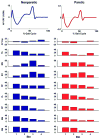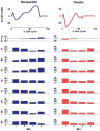Relationships between muscle activity and anteroposterior ground reaction forces in hemiparetic walking
- PMID: 17826457
- PMCID: PMC2367107
- DOI: 10.1016/j.apmr.2007.05.027
Relationships between muscle activity and anteroposterior ground reaction forces in hemiparetic walking
Abstract
Objective: To determine relationships between muscle activity and propulsive impulse in hemiparetic walking.
Design: Cross-sectional.
Setting: Gait analysis laboratory.
Participants: Forty-nine poststroke patients with chronic hemiparesis, stratified into hemiparetic severity subgroups based on Brunnstrom stages of motor recovery, walking at their self-selected speed.
Interventions: Not applicable.
Main outcome measures: Percent of muscle activity in the paretic and nonparetic legs and net anteroposterior (AP) ground reaction force impulse (ie, the time integral of the AP ground reaction force) within 4 regions of the stance phase (first double support, first and second halves of single support, and second double support).
Results: Medial gastrocnemius and soleus muscle activity correlated positively with paretic propulsion in the second half of single support and double support across all subjects and subjects grouped by hemiparetic severity. Tibialis anterior correlated negatively with paretic propulsion during preswing across all subjects and for subjects with moderate and severe hemiparesis. Rectus femoris activity also correlated negatively with preswing propulsion for the severe group. Uniarticular knee extensor activity correlated only with increased paretic braking in the first double-support phase for the severe hemiparesis group. Nonparetic leg muscle activity correlated with propulsive impulses across all subjects, but not within the severe group exclusively.
Conclusions: Paretic propulsion is strongly associated with increased plantarflexor activity and also negatively associated with increased leg flexor activity, especially in the severe hemiparesis group. These results suggest that exaggerated flexor muscle activity may counteract the effects of the plantarflexors by offloading the leg and interfering with the limb's ability to generate appropriate AP ground reaction forces. There is also evidence for specific relationships between paretic braking and nonparetic propulsive forces and changes in timing of muscle activation.
Figures




Similar articles
-
Leg extension is an important predictor of paretic leg propulsion in hemiparetic walking.Gait Posture. 2010 Oct;32(4):451-6. doi: 10.1016/j.gaitpost.2010.06.014. Epub 2010 Jul 24. Gait Posture. 2010. PMID: 20656492 Free PMC article.
-
Contribution of Paretic and Nonparetic Limb Peak Propulsive Forces to Changes in Walking Speed in Individuals Poststroke.Neurorehabil Neural Repair. 2016 Sep;30(8):743-52. doi: 10.1177/1545968315624780. Epub 2015 Dec 31. Neurorehabil Neural Repair. 2016. PMID: 26721869 Free PMC article.
-
Relationship between step length asymmetry and walking performance in subjects with chronic hemiparesis.Arch Phys Med Rehabil. 2007 Jan;88(1):43-9. doi: 10.1016/j.apmr.2006.10.004. Arch Phys Med Rehabil. 2007. PMID: 17207674
-
Paretic propulsion as a measure of walking performance and functional motor recovery post-stroke: A review.Gait Posture. 2019 Feb;68:6-14. doi: 10.1016/j.gaitpost.2018.10.027. Epub 2018 Oct 25. Gait Posture. 2019. PMID: 30408710 Free PMC article. Review.
-
Contributions to the understanding of gait control.Dan Med J. 2014 Apr;61(4):B4823. Dan Med J. 2014. PMID: 24814597 Review.
Cited by
-
The influence of merged muscle excitation modules on post-stroke hemiparetic walking performance.Clin Biomech (Bristol). 2013 Jul;28(6):697-704. doi: 10.1016/j.clinbiomech.2013.06.003. Epub 2013 Jul 2. Clin Biomech (Bristol). 2013. PMID: 23830138 Free PMC article. Clinical Trial.
-
Coordination of the non-paretic leg during hemiparetic gait: expected and novel compensatory patterns.Clin Biomech (Bristol). 2012 Dec;27(10):1023-30. doi: 10.1016/j.clinbiomech.2012.08.005. Epub 2012 Sep 13. Clin Biomech (Bristol). 2012. PMID: 22981679 Free PMC article.
-
Patterns of change in propulsion force and late braking force in patients with stroke walking at comfortable and fast speeds.Sci Rep. 2024 Sep 27;14(1):22316. doi: 10.1038/s41598-024-74093-1. Sci Rep. 2024. PMID: 39333754 Free PMC article.
-
Impaired H-Reflex Adaptations Following Slope Walking in Individuals With Post-stroke Hemiparesis.Front Physiol. 2019 Oct 1;10:1232. doi: 10.3389/fphys.2019.01232. eCollection 2019. Front Physiol. 2019. PMID: 31632287 Free PMC article.
-
Altered post-stroke propulsion is related to paretic swing phase kinematics.Clin Biomech (Bristol). 2020 Feb;72:24-30. doi: 10.1016/j.clinbiomech.2019.11.024. Epub 2019 Nov 29. Clin Biomech (Bristol). 2020. PMID: 31809919 Free PMC article.
References
-
- Perry J, Garrett M, Gronley JK, Mulroy SJ. Classification of walking handicap in the stroke population. Stroke. 1995;26:982–9. - PubMed
-
- Bohannon RW. Gait performance of hemiparetic stroke patients: selected variables. Arch Phys Med Rehabil. 1987;68:777–81. - PubMed
-
- Richards CL, Malouin F, Dumas F, Tardif D. Gait velocity as an outcome measure of locomotor recovery after stroke. In: Craik L, Oatis C, editors. Gait analysis: theory and application. St Louis: Mosby; 1995. pp. 355–64.
-
- Brandstater ME, de Bruin H, Gowland C, Clark BM. Hemiplegic gait: analysis of temporal variables. Arch Phys Med Rehabil. 1983;64:583–7. - PubMed
-
- Bowden MG, Balasubramanian CK, Neptune RR, Kautz SA. Anterior-posterior ground reaction forces as a measure of paretic leg contribution in hemiparetic walking. Stroke. 2006;37:872–6. - PubMed
Publication types
MeSH terms
Grants and funding
LinkOut - more resources
Full Text Sources
Medical

